Since the invention of photography there have been several mediums used to create images. Before the invention of digital cameras, people took photographs using glass, paper, metal and even plastic. When the first camera film was invented, it was comprised of a plastic material known as celluloid because it was adapted cinema film. The invention of plastic film in the late 1880s is what made photography so available to the masses and made it possible for everyone to own a camera because it made photographic film cheap and easy to produce consistently. However, photographic film is only one part of what is needed for creating a print in the darkroom. The other things needed are photographic paper, an enlarger, photographic chemicals, and the most important part – a safelight.
A red or amber light is used in the darkroom to not expose black & white darkroom paper to light when creating a print in the darkroom. Red or amber safelights are used for black & white darkroom paper because they don’t produce the color of light that affects this type. A faint yellow safelight can be used with color darkroom paper but it is more common make color prints in the dark and process the print using a color paper processing machine.
Below we will discuss how darkrooms are still used, why we need darkrooms, and what colors can be used in darkrooms besides red.
Are Darkrooms Still Used?
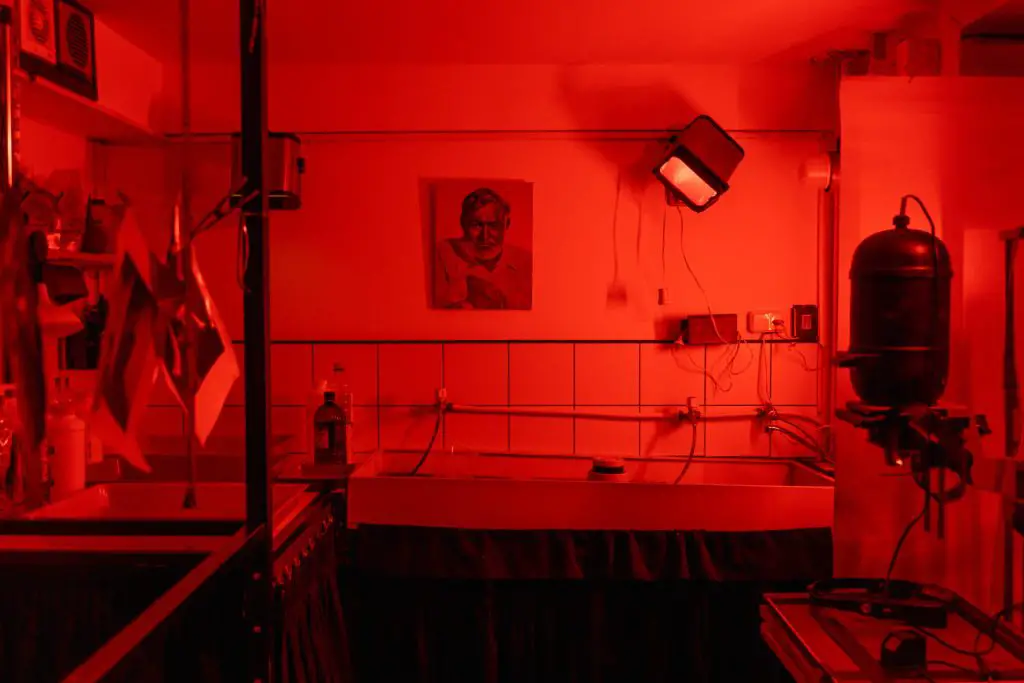
Back in the late 1800s, camera film was first invented by George Eastman. The first types of camera film utilized celluloid, a plastic substance covered in a photo sensitive material called silver halide crystals that help create images taken by a camera.
Although the invention of the digital camera has made the use of photographic film less popular, plenty of professional and enthusiast photographers still rely on darkrooms to produce color and black & white prints. Some photographers prefer to use film and darkroom photography because of its hands-on quality.
So, while darkrooms are not as popular as they once were, they are still used often today. When making prints in a photography darkroom using a darkroom enlarger, film negatives are placed into the enlarger to create a projection of the original image to the paper below. Then the image is revealed on the paper when it is processed through the developing chemicals. Read this article for more information about making a print in the darkroom or this article about what it costs to build a darkroom
or this article about what it costs to build a darkroom yourself.
yourself.
Why Are Darkrooms are Essential to Photography?
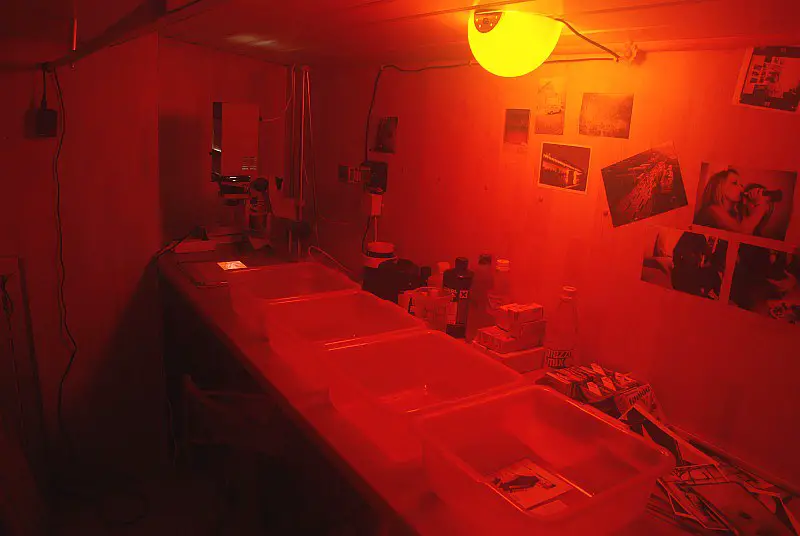
Darkrooms are essential to photography because of how darkroom enlarging paper works. Darkroom printing paper has a sensitivity to blue light, so darkrooms are set up to avoid that particular color in the visible light spectrum. Using a safelight with a red, or amber, filter helps to prevent any blue light from coming through and affecting the development of the photographic paper. Using a red filter doesn’t harm black & white photography paper when using a film negative to create a darkroom print. After a print is processed through all of the necessary chemicals, it is fixed and can be viewed in regular light and not be ruined.
Safelights operate as lighting fixtures that you find in a photographic darkroom. The safelight emits a light source limited to a specific visible light spectrum so that light-sensitive items, like photographic paper or chemicals used when developing paper, are not ruined. Without the use of a safelight, developing a photographic print would be difficult because it would need to be done in complete darkness.
Can I Use A Red Light To Develop Film?
The only film you can use a red light when developing it is orthochromatic black & white film which is not sensitive to red light (red appears black in the images). However, most black & white film produced now is panchromatic and sensitive to red light, including a red safelight. Therefore unless you are developing orthochromatic film, a red light should only be used in the darkroom while processing black & white darkroom enlarging paper.
What Is Orthochromatic Film?
Orthochromatic film was the first film to be developed in the late 1800’s and is sensitive to violet, blue, green, and yellow light but not red light. Because of this, unlike most photographic film, it can be developed under a red light. In the early 1900’s panchromatic film was created and is sensitive to all waves length like most black & white film produced today. Since orthochromatic film is not sensitive to red light, it is used in forensic photography because it blood stains stand out in the image. Orthochromatic film also darkens freckles and brings out skin texture in faces when used in portraiture, similar to early wet plate photography processes. See this great article on The Darkroom.com website for more about the difference between orthochromatic and panchromatic films and what they look like under similar conditions.
on The Darkroom.com website for more about the difference between orthochromatic and panchromatic films and what they look like under similar conditions.
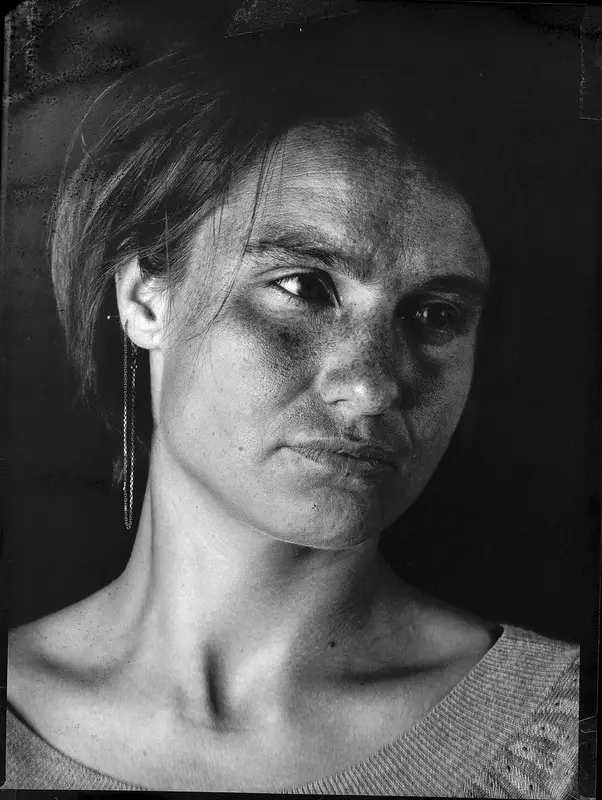
Keep in mind when loading film other than orthochromatic black & white film onto the film reel of your developing tank, it should be done in complete darkness. See this article about how to develop black & white film yourself at home. If you are more interested in learning what it takes to develop color film yourself at home
at home. If you are more interested in learning what it takes to develop color film yourself at home , see this article.
, see this article.
Is Color Film Sensitive To Red Light?
Yes, color film is sensitive to all light. When you load your from your film roll or canister into the developing tank to be processed, it should be done in complete darkness.
Is There Any Color Used in the Darkroom Other Than Red?
While red is the most well-known color for safelights usually used in darkrooms, it’s not the only color that photographers use when developing prints. Other colors than red that can be used as a safelight in the darkroom. Some of these include:
than red that can be used as a safelight in the darkroom. Some of these include:
- Amber
- Light-Amber
- Greenish-Yellow
- Green and Dark Green
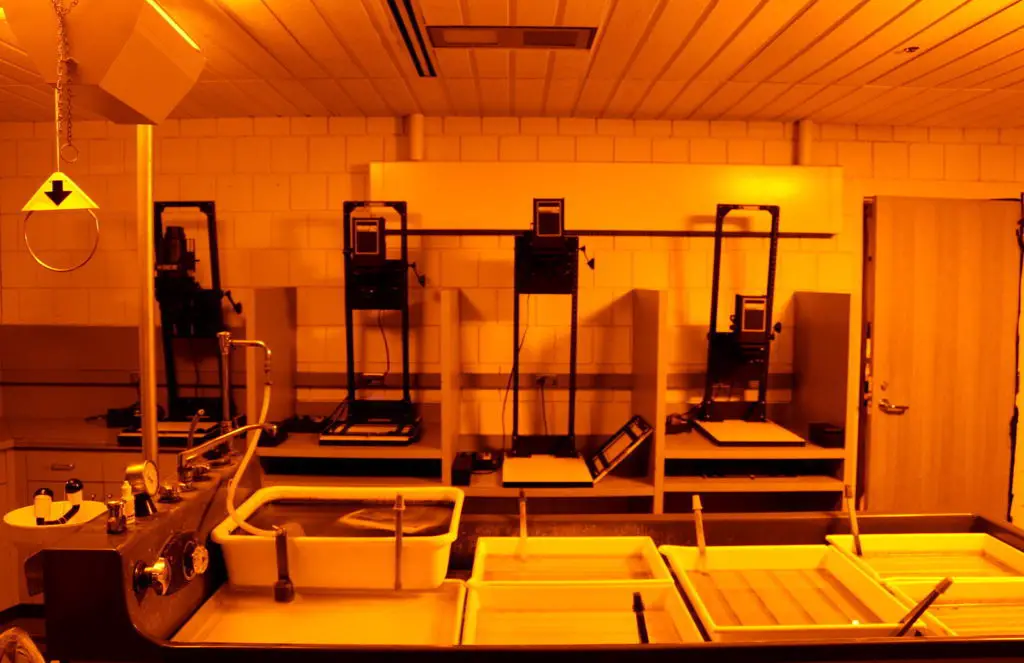
Depending on the spectrum range of light that’s needed for the development of photographic paper these other colors can be used. When selecting the color of safelight you need to use, you’ll need to figure out the visible light spectrum range that is compatible with your photographic paper. If you aren’t certain about the light spectrum, then refer to the manufacturer’s recommendations of your darkroom paper. Knowing the range will help you narrow down the color of light that is compatible with the enlarging paper to use in your darkroom.
What Color Safelight Do I Need?
Different types of safelights exist depending on the type of light-sensitive material you are using. Before picking a safelight, it’s essential to ensure that it will protect the type of material you are working with.
Color Darkroom Paper
Color negative photographic paper is sensitive to all light wavelengths so it must be processed in complete darkness which is usually done in tubes or by machine. However, the JOBO company has produced a light called the Maxilux that can work with both black & white paper and color paper using LED lights and is best used on the lowest setting for color paper. Find it for sale here here .
.
Black & White Darkroom Paper
When it comes to normal black & white printing paper, using a red or amber safelight is the best way to go. Here is a red safelight that I recommend from the Freestyle Photo website.
the Freestyle Photo website.
Panchromatic Darkroom Paper
Panchromatic photography paper is black & white darkroom printing paper that is sensitive to all light and is prized for its ability to be used as a paper negative in pinhole and large format cameras. This paper is sensitive to all wavelengths of light, similar to color paper, but produces a black & white print. This means that most people develop the paper in total darkness like color darkroom printing paper but using black & white chemicals. This paper can use an amber, green, or dark green safelight – depending on the type of paper used.
What Is Safelight Fog?
Safelight fog is when the safelight is installed too close to the enlarger or work area, no less than 4 feet away, in the darkroom. The paper can appear unevenly across a partial section or the entire paper. It usually happens when the enlarging paper is transferred between locations in the darkroom. This can include transfering the paper to the paper safe (a box that keeps light out), to the light-tight packaging, to the enlarger, or to the darkroom chemicals and also while it is sitting on the enlarger waiting to be exposed.
(a box that keeps light out), to the light-tight packaging, to the enlarger, or to the darkroom chemicals and also while it is sitting on the enlarger waiting to be exposed.
Safelight fog can also happen if the light is too bright or the incorrect color for the enlarging paper being used.
Unfortunately, the only way to know for sure if your paper has been fogged is to process the paper through the darkroom chemicals. Fogged paper will have low contrast with little to no detail in the shadow area or highlight areas. See this article for more about testing fogged darkroom paper .
.
The best way to prevent safelight fog is to place your paper on your work area and let it sit for 5 – 10 mins and the process it using the darkroom chemicals.
Creating A Print in Darkroom Using A Safelight
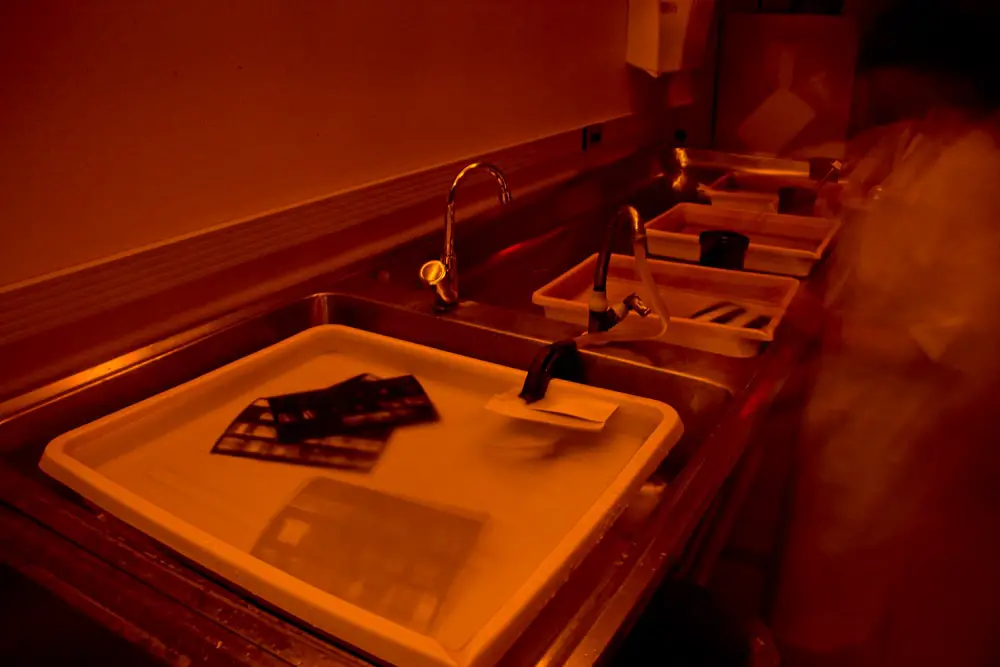
When it comes to making a black & white photographic print, you’ll have to use a darkroom. We use darkrooms that feature red light because it keeps the sensitive black & white photo paper and chemicals from being exposed to any unwanted light.
Below are the general steps for making a print in the darkroom but for more detailed information for making a print in the darkroom see this article .
.
First, make sure no white light can enter the area of the darkroom before you enlarge your negative. That also means making sure nothing like the following is allowed into the room:
- Flash photography
- No lights
- Nothing that glows, like your cellphone
Don’t turn on the lights in the room until the black & white photographic paper is hidden, and nobody is working in the room. If any light comes into the room other than the red light, the sensitive paper will be exposed and ruined, and the prints will all turn black when developed.
Also, remember while working in the darkroom to avoid placing your hands into any of the development chemicals. Instead, it would be best if you always used tongs, or nitrile gloves, to avoid coming into contact. You don’t want any of these chemicals to touch your skin because you can transfer them to the photographic paper without knowing until you develop your paper or you could develop an allergy to the chemicals overtime.
When in the darkroom creating a photographic print, all you need to do is:
- Put the negative into the holder in the enlarger
- Focus your negative
- Time the amount of light exposure you need
- Put one sheet of photogenic paper with its shiny side up on the bottom of the enlarger
- Expose your paper to the correct amount of light
- Run your paper through the development chemicals
If during this process, you need some lighting to tell what you are doing, turn on your red safelight. Once you are done with these steps, you’ll need to place your paper into the chemicals for development. They’ll need to sit in the chemicals according the manufacturer’s directions and be washed in water between 5 – 10 minutes. After that, you can dry them off, and you should have your final print.
Final Thoughts
Darkrooms are still used today to develop film because photographic paper can react to light. So, that light must be controlled when enlarging and developing a photographic print, or the paper can get ruined or exposed. Developing pictures like this require a room to be dark, hence the name darkroom. Nowadays, we still see these types of rooms for developing traditional types of prints.
because photographic paper can react to light. So, that light must be controlled when enlarging and developing a photographic print, or the paper can get ruined or exposed. Developing pictures like this require a room to be dark, hence the name darkroom. Nowadays, we still see these types of rooms for developing traditional types of prints.
Although developing paper in darkrooms today isn’t as popular as it once was, many photographers still use darkrooms for print development. Darkrooms allow for the successful creation of photographs because the photographer can control the condition and lighting available inside of the room. For photographers that prefer to work with traditional film cameras rather than digital camera, darkrooms are still essential today.
camera, darkrooms are still essential today.
